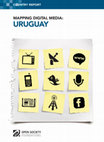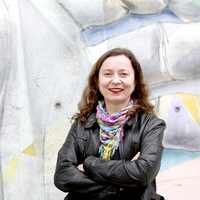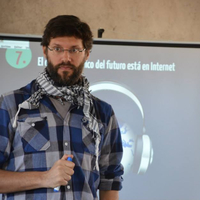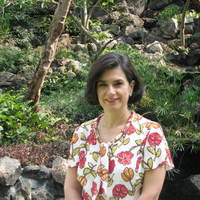Papers by Rosario Radakovich

The Mapping Digital Media project examines the global opportunities and risks created by the tran... more The Mapping Digital Media project examines the global opportunities and risks created by the transition from traditional to digital media. Covering 60 countries, the project examines how these changes affect the core democratic service that any media system should provide: news about political, economic, and social affairs.The digital media environment in Uruguay is developing rapidly due to a small population, sustained economic growth, a policy focus on universal service goals, and a strong legacy of social movements and civil society institutions.But private media ownership remains significantly concentrated in the hands of an oligopoly of wealthy families. Despite the proliferation of news platforms and outlets, diversity has not increased at all, due to the lack of original and independent online content.Recent reforms have improved the transparency and independence of broadcast licensing procedures (although the government still retains significant control over the award of sp...
Les enquêtes sur les pratiques culturelles
El Observatorio Universitario de Políticas Culturales presenta el 2do. Informe sobre Imaginarios ... more El Observatorio Universitario de Políticas Culturales presenta el 2do. Informe sobre Imaginarios y Consumo Cultural en Uruguay. Los datos son el resultado de una encuesta realizada a nivel nacional (3.421 casos). El Informe consta de dos partes: la primera estudia los imaginarios y consumos culturales a nivel nacional y focaliza su interés en el estudio de los audiovisuales. La segunda parte estudia los casos de Florida y Maldonado
Facultad de Humanidades y Ciencias de la Educación, UdelaR, 2014
El Observatorio Universitario de Políticas Culturales radicado en la Facultad de Humanidades y Ci... more El Observatorio Universitario de Políticas Culturales radicado en la Facultad de Humanidades y Ciencias de la Educación de la Universidad de la República presenta el Tercer Informe Nacional sobre consumo y comportamiento cultural. Uruguay 2014. Este informe se inscribe en la línea de investigación que viene desarrollando el Observatorio desde el año 2002 y fue realizado en el marco del Convenio suscripto entre la Universidad de la República y el Ministerio de Educación y Cultura.

Versión. Estudios de Comunicación y Política, Oct 30, 2015
Film consumption in Uruguay. About national cinema's tastes and social value. Pp. 100-112, en Ver... more Film consumption in Uruguay. About national cinema's tastes and social value. Pp. 100-112, en Versión. Estudios de Comunicación y Política Número 36/mayo-octubre 2015, ISSN 2007-5758 <http://version.xoc.uam.mx> Resumen: El artículo explora el gusto cultural y la valoración social de la cinematografía uruguaya en los primeros años del siglo XXI. Dentro del análisis, se plantean los mecanismos de legitimación del cine uruguayo, la valoración de expresiones culturales tradicionales, como la literatura en relación con el audiovisual, los criterios de definición del "buen gusto" y el valor de los mecanismos internacionales de consagración cinematográfica. Para la metodología, se efectuó un análisis de contenido sobre 1.056 registros de comentarios web de espectadores en una página electrónica de agenda cultural en Uruguay, la cual incluye una muestra de 15 películas producidas y estrenadas en los años 2000, así como el análisis estadístico de una encuesta de imaginarios y consumo cultural de los uruguayos de 2.700 casos, levantada en 2014. El presente texto es parte de un proyecto mayor de investigación, desarrollado por el grupo
Comunicación y Medios, 2020

Aesthetic Cosmopolitanism and Global Culture, 2020
Gathering scholars from five continents, this edited book displaces the elitist image of cosmopol... more Gathering scholars from five continents, this edited book displaces the elitist image of cosmopolitan as well as the blame addressed to aesthetic cosmopolitanism often considered as merely cosmetic. By considering aesthetic cosmopolitanism as a tool to understand how individuals and social groups appropriate the sphere of culture in a global world, the authors are concerned with its operationalization on two strongly interwoven levels, macro and micro, structural and individual. Based on the discussion of theoretical perspectives and empirically grounded research (qualitative and quantitative, conducted in many countries), this volume unveils new insights, on tourism and food, architecture and museums, TV series and movies, rock, K-pop and samba, by providing resources for making sense of aesthetic preferences in a global perspective. Contributors are: Felicia Chan, Vincenzo Cicchelli, Talitha Alessandra Ferreira, Paula Iadevito, Sukhmani Khorana, Anne Krebs, Antoinette Kujilaars, Franck Mermier, Sylvie Octobre, Joana Pellerano, Rosario Radakovich, Motti Regev, Viviane Riegel, Clara Rodriguez, Leslie Sklair, Yi-Ping Eva Shi, Claire Thoumelin and Dario Verderame.
Espacio Abierto, Jun 1, 2005

Pobreza y desigualdad en Uruguay: una relación en debate El trabajo pretende ser una contribución... more Pobreza y desigualdad en Uruguay: una relación en debate El trabajo pretende ser una contribución a conformar espacios interdisciplinarios para identificar temas y problemas comunes a desarrollar e investigar en el país. En este sentido, se busca identificar necesidades, temas y líneas de investigación académicas contemporáneas. La relevancia de la temática surge tanto desde el espacio profesional, como de la sociedad y del sistema político en su conjunto. La complejidad y diversidad creciente de los problemas sociales estimula el desarrollo de abordaje de carácter interdisciplinario para su comprensión. La interdisciplina se entiende como espacio académico institucional y de práctica para la convergencia de perspectivas, en líneas de investigación, y métodos de distintas disciplinas para el abordaje de una problemática social compleja. Por tanto, la red temática Desarrollo, Desigualdad y Protección Social en Uruguay se propone generar espacios transversales para el estímulo de prácticas y elaboración de iniciativas de proyectos interdisciplinarios entre investigadores académicos de la UDELAR referidos a la temática de los modelos de políticas públicas, sistemas de protección social y desigualdad social.

The Mapping Digital Media project examines the global opportunities and risks created by the tran... more The Mapping Digital Media project examines the global opportunities and risks created by the transition from traditional to digital media. Covering 60 countries, the project examines how these changes affect the core democratic service that any media system should provide: news about political, economic, and social affairs. The digital media environment in Uruguay is developing rapidly due to a small population, sustained economic growth, a policy focus on universal service goals, and a strong legacy of social movements and civil society institutions. But private media ownership remains significantly concentrated in the hands of an oligopoly of wealthy families. Despite the proliferation of news platforms and outlets, diversity has not increased at all, due to the lack of original and independent online content. Recent reforms have improved the transparency and independence of broadcast licensing procedures (although the government still retains significant control over the award of...
El articulo analiza las modalidades de reconversion y adaptacion de los canales publicos a la ter... more El articulo analiza las modalidades de reconversion y adaptacion de los canales publicos a la tercera generacion de medios audiovisuales, en un contexto de globalizacion y mundializacion de la cultura. Varios estudios coinciden en la relevancia de la television publica como forma de garantizar un espacio para la discusion y el interes general. En este sentido, la television publica podria reflejar en su pantalla contenidos alternativos a los seleccionados por el mercado. El trabajo analiza la television publica en Uruguay en los ultimos anos, comparando el canal municipal de Montevideo Teve Ciudad (en television cable) y el canal publico nacional (Canal 5). En particular, se analiza la instalacion de la television cablemunicipal (Teve Ciudad), como canal de proximidad que desarrollo una politica de difusion masiva de la cultura local
This article examines data on the audience of the 34th and 35th Uruguayan Cinematheque Internatio... more This article examines data on the audience of the 34th and 35th Uruguayan Cinematheque International Film Festival held in Montevideo in 2016 and 2017. While the festival is attended by a heterogeneous audience, the most devoted spectators define their love for cinema as a passion. This text offers data obtained from two non-probabilistic surveys taken at these Festivals (450 people in 2016 and 403 in 2017) within the research framework devised by the CreA Group of the Facultad de Informacion y Comunicacion de la Universidad de la Republica – Uruguay.
Este articulo analiza la diversificacion de los usos sociales de Internet en la vida cotidiana de... more Este articulo analiza la diversificacion de los usos sociales de Internet en la vida cotidiana de los uruguayos en los ultimos anos, a partir del analisis de las practicas y competencias adquiridas en diversos campos de actividad: social, politico y cultural. Se considera que una vez "superados" los principales obstaculos del acceso digital, la desigualdad social se expresa en las competencias adquiridas para usos complejos y estrategicos en Internet. El articulo utiliza parte del relevamiento de campo de una investigacion mas amplia, denominada Mapping Digital Media - Uruguay, realizada entre 2011 y 2013 por investigadores del Programa de Desarrollo de la Informacion y la Comunicacion (PRODIC) y el Observatorio de Tecnologias de Informacion y Comunicacion (Observa TIC) de la Universidad de la Republica
Studies in Spanish & Latin-American Cinemas, 2019
La categoría "Otro" incluye asiáticos, indígenas y personas que prefi rieron no revelar sus antec... more La categoría "Otro" incluye asiáticos, indígenas y personas que prefi rieron no revelar sus antecedentes étnicos.









Uploads
Papers by Rosario Radakovich
4o Seminario Internacional Pensando la Cultura
FIC FHUCE UDELAR
Invitados: Prof. RENATO ORTIZ - Prof. ALBERTO QUEVEDO
26 y 27 de setiembre, 2018
Montevideo, Uruguay
Nevertheless, public television, seems to cross a crisis period, that questions their own existence, the contents of the programming, the relation established with the public and the existing policies or institutional designs (financing policies, political independence, recruitment of human resources). In the Latin American context, according some researchers (Martin-Barbero, Rincon, Fuenzalida), public television need a resignification, and need the development of an endogenous model of public television. Also, this reframing is present in diverse contexts at world-wide level, where emphasizes the recovery of the original social assignment in the public television, for example in the United States, in the denominated “broken promise”of Public Broadcasting Service from Jerold Starr (2001).
In Uruguay, public television has forty years of existence in the country with Channel 5, today National Television. The creation of “Tevé Ciudad” (City`s tv) in 1996 hit of diverse ways at local level. In principle it reframed the debate on the roll of the public television in the national tv context. Also, the insertion of the channel in the television cable of Montevideo changed the relations between the public and private tv, as well as in the national and municipal space of the state channels.
Popular practices like football, carnival -“candombe” in particular- and tango generate powerful social identification, even at the present. Middle classes leisure activities also have centrality, because its tastes and cultural practices are legitimated as “national”. The myth of the “educated and cult” country still remains, and cultural capital is a significant aspect when it comes to leisure time activities.
Finally, family and friends are important features of Uruguayans’ socialization habits but in recent times there is an inconsistency between the population’s wishes regarding leisure time activities and reality. Leisure time is a good indicator of happiness and unhappiness, imaginaries and realities of a South-American country that is changing in the globalization context.
Cinephiles’ comments show the classic dichotomies of differentiation between the film industry and independent productions. This raises the issue of the intersections and “hybridity” (García Canclini) among the artistic, popular and massive representations in both national and international Latin-American cultural features and shows how more or less intellectualized; snobs or omnivorous (Peterson) visions about film consumption become more evident.
On the other hand, the relationship between global, national and local matters, or the ways in which the “world culture” (Ortiz) is assessed, gets reevaluated from the connection between cosmopolitanism and parochialism in the hierarchy of international festivals and awards.
This paper is part of a longer project called “CINEMA. Cinema and audiovisual mediations” which is being developed by an investigation group named “Culture, consumption and audiovisual creativity” which I coordinate from PRODIC-FIC UDELAR (Uruguayan State University) since 2010.
This research is based on a quantitative and quality approach which involved: a self-made survey, which states the opinions of one thousand three hundred / thirteen hundred audiovisual specialists on regards national cinema’s image and social imaginary; content analysis of four journalists’ reviews on account of a sample of 15 films (the ones with greater box office; greater submission to festivals and major awards) published on daily or weekly printed media; and the revision of content from nine hundred eighty three records of comments from cinephiles, published on a specialized cultural agenda in Uruguay via web, regarding eight (ten) films produced and released during the last decade with greater festival appearance, international awards and/or local box office.